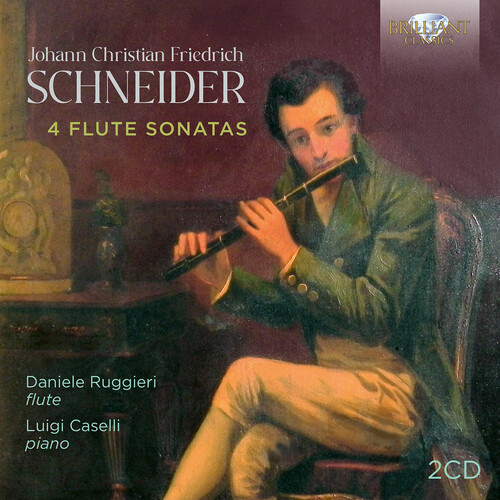Show results for
Deals
- 4K Ultra HD Sale
- 50s Films Sale
- Action Sale
- Alternative Rock Sale
- Anime sale
- Award Winners Sale
- Bear Family Sale
- Blu ray Sale
- Blues on Sale
- British Sale
- Christmas in July
- Classical Music Sale
- Comedy Music Sale
- Comedy Sale
- Country Sale
- Criterion Sale
- Electronic Music sale
- Folk Music Sale
- Horror Sci fi Sale
- Kids and Family Sale
- Metal Sale
- Music Video Sale
- Musicals on Sale
- Mystery Sale
- Naxos Label Sale
- Page to Screen Sale
- Paramount Sale
- Rap and Hip Hop Sale
- Reggae Sale
- Rock
- Rock and Pop Sale
- Rock Legends
- Soul Music Sale
- TV Sale
- Vinyl on Sale
- War Films and Westerns on Sale

Schneider: 4 Flute Sonatas
- Format: CD
- Release Date: 8/15/2025

Schneider: 4 Flute Sonatas
- Format: CD
- Release Date: 8/15/2025
- Composers: Johann Christian Friedrich Schneider
- Label: Brilliant Classics
- Number of Discs: 2
- UPC: 5028421970608
- Item #: 2719889X
- Genre: Classical Artists
- Release Date: 8/15/2025
Product Notes
World premiere recordings of beguiling flute sonatas written on the cusp of the early-Romantic era in Germany.
Almost completely forgotten in our own time, Johann Christian Friedrich Schneider (1786-1853) once enjoyed substantial fame as a pianist, composer, teacher and musical organiser. He was born in 1786, 16 years after Beethoven, in the same year as Weber and the Brothers Grimm, and received his first musical education from his father. His talent was evident from an early age, as he learnt the piano and several other instruments. Breitkopf & Hartel published his Op.1, a set of piano sonatas, in 1804; he went to study in Leipzig, where he became organist of the Thomaskirche, and settled there for his 20s, giving the local premiere of Beethoven's 'Emperor' Concerto in 1811. A standard German work of reference from 1838 cites Schneider 'among the living German masters of music'. From the evidence of these four sonatas for flute and piano, it is hard to see why his name should have so comprehensively vanished from view. Schneider composed the first of them, his Op.18, in 1808, and it follows the same Classical exemplar as Beethoven's first eight violin sonatas, and all of Mozart's in being written for a pianist with an accompanying melody instrument rather than the other way around. Over the course of the following three sonatas, the flautist becomes more independent, and his Op.61 Sonata of 1827 requires a virtuoso. Schneider wrote the first three sonatas in a four-movement form, breaking ground in this way by elevating the flute sonata from it's previous association with pretty variation sets and pot-pourris of operatic themes. This originality extends to the finales of all four sonatas - notably the Second, which is cast in G minor against the prevailing G major tonality (foreshadowing in this way the 'Italian' Symphony of Mendelssohn). In his booklet essay for this new recording, the flautist Daniele Ruggeri pays tribute to the 'simple but bewitching' trios of each sonata, and to Schneider's 'profound understanding of the expressive character of the different registers of the flute' in the slow movements. Based in Venice, Ruggeri has played across the world and recorded for many major labels. With this album of Schneider he revives an unjustly neglected contemporary of Beethoven and Schubert, and does so on an instrument of the period. - Johann Christian Friedrich Schneider was a German composer, conductor, organist, and pianist of the early Romantic period. Born in Saxony, he was a highly respected musician during his lifetime, known for his contributions to church music, orchestral works, and chamber compositions. He earned his place in history as the pianist premiering Beethoven's 5th piano concerto. - Schneider's flute sonatas are elegant and expressive works that reflect the stylistic transition from the Classical to the Romantic era. Blending lyrical melodies with intricate harmonic textures, the sonatas are technically challenging and musically rewarding for performers. The flute sonatas follow the traditional sonata form, typically structured in three or four movements, combining virtuosic passages with expressive slow sections. - Played by Italian flutist Daniele Ruggieri and pianist Luigi Caselli.

